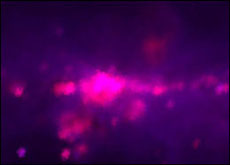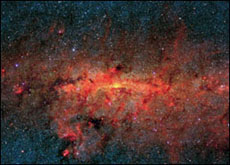|
 |

 |

| The
central region of the Milky Way as seen in infrared
light by the IRAS mission 20 years ago. |
|
 |
WISE will survey the entire sky in a portion
of the electromagnetic spectrum called the mid-infrared with
far greater sensitivity than any previous mission or program ever
has. The WISE survey will consist of over a million images, from
which hundreds of millions of astronomical objects will be catalogued,
providing a vast storehouse of knowledge about the Solar System,
the Milky Way, and the Universe.
Within our Solar System, asteroids absorb
most of the sunlight that hits them and heat up to glow in the
mid-infrared. WISE will be able to measure the diameters of more
than 100,000 asteroids. WISE will also see the infrared light absorbed
and reemitted by dust, called Zodiacal Light, as well as the debris
trails of comets.
Some of the material making up the Sun's planetary
debris disk is left over from the formation of the Solar System,
and some is freshly generated by collisions between the asteroids
and planets that exist today. Beyond the Solar System, WISE will
provide a complete inventory of nearby young stars and their dusty
disks, as well as of the debris disks associated with planetary
systems around thousands of older nearby stars.

| The
central region of the Milky Way Galaxy as WISE will
see it with much greater sensitivity. |
|
 |
 |
In the neighborhood of the Sun, WISE will
discover stars cooler and dimmer than the Sun, which are thought
to be the most common types of stars by far. Brown Dwarfs are stars
lacking the mass needed to fuse hydrogen into helium like visible
stars do. They slowly radiate away their heat of formation, cooling
from red hot to room temperature and below. WISE will find many
such Brown Dwarf stars in the solar neighborhood, most of which
have yet to be discovered. Some may even be closer to the Sun than
any other star previously known.
Interstellar dust prevents us from seeing more than a few percent of the stars
in the Milky Way in visible light. However, infrared light passes through the
dust allowing WISE to map the global structure of our Galaxy. WISE will also
detect infrared light emitted by this interstellar dust, producing very good
maps of dust in the Galaxy.
Beyond the Milky Way, WISE imagery will allow for the study of
the structures and star formation histories of thousands of nearby
galaxies.
Farther away, WISE will find the most luminous galaxies in the Universe, called
Ultra-Luminous Infrared Galaxies (ULIRGs), which result from the merger of
galaxies triggering intense bursts of star formation, most of which is enshrouded
by clouds of dust. WISE will also probe and characterize the population of active
galactic nuclei (AGN) that
are obscured heavily by dust and that have not yet been discovered by studies
in the visible or ultraviolet parts of the electromagnetic spectrum.
Clusters of galaxies found in the WISE survey will allow for further study
of the mysterious dark energy that is responsible for the acceleration of the
Universe.
|
 |





